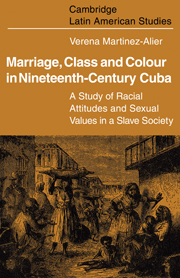 Marriage, Class and Colour in Nineteenth Century Cuba
Marriage, Class and Colour in Nineteenth Century Cuba When I first went to Cuba in 1967 my intention was to study its present-day family organization. I wanted to test the various hypotheses developed by sociologists and social anthropologists on family structure in other parts of the Caribbean and examine the extent to which the 1959 revolution had already brought about changes in the Cuban family. For bureaucratic reasons, however, I was only able to spend two months in the field in a small, predominantly coloured coffee-growing village in the Sierra Maestra. This brief stay allowed me to gain an overall impression of the villagers' family organization – the prevalence of stable consensual unions – but was clearly insufficient to understand its complexities, and much less to assess the impact of the revolution, although there were many indications that it had already affected family values in some ways. Thus I was often asked by the villagers, and in particular by the women, whether I had been sent by the revolutionary government in connection with the ‘collective marriage’ campaign, which had already reached other parts of the island and whose aim it was to give those couples who had so far lived in concubinage the opportunity to marry formally. While the women seemed to welcome this measure, men appeared to be more evasive. Also, the local political secretary, one of the judges of the local people's court, and the secretary of the peasant association pointed out repeatedly that as high-ranking members of the community they would have to get formally married at some point.
To save this book to your Kindle, first ensure [email protected] is added to your Approved Personal Document E-mail List under your Personal Document Settings on the Manage Your Content and Devices page of your Amazon account. Then enter the ‘name’ part of your Kindle email address below. Find out more about saving to your Kindle.
Note you can select to save to either the @free.kindle.com or @kindle.com variations. ‘@free.kindle.com’ emails are free but can only be saved to your device when it is connected to wi-fi. ‘@kindle.com’ emails can be delivered even when you are not connected to wi-fi, but note that service fees apply.
Find out more about the Kindle Personal Document Service.
To save content items to your account, please confirm that you agree to abide by our usage policies. If this is the first time you use this feature, you will be asked to authorise Cambridge Core to connect with your account. Find out more about saving content to Dropbox.
To save content items to your account, please confirm that you agree to abide by our usage policies. If this is the first time you use this feature, you will be asked to authorise Cambridge Core to connect with your account. Find out more about saving content to Google Drive.